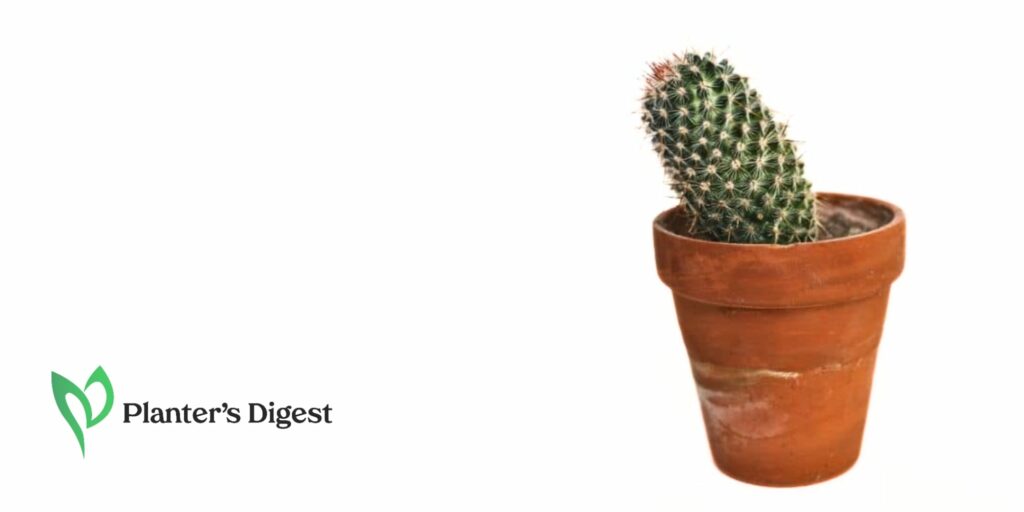No, that’s not the Leaning Tower of Pisa – it’s your cactus! Cacti are often expected to grow straight up, so it can be a bit mysterious if they begin to lean in one direction.
But why could this be? Let’s explore why cacti lean and get effective solutions for the condition. Let’s start!
Why Your Cactus Leans
It might have taken you some time to notice that your cactus is leaning, and we don’t blame you. After all, it certainly didn’t happen overnight.
Your cactus is leaning due to factors such as root or stem rot, lighting conditions, pests, weight, watering issues, genetics, pot size, and potting soil.
Let’s explore each of these in more detail.
Root or Stem Rot

How to Fix: Let soil dry before watering. Use a pot with drainage holes. If there’s severe rot, replant.
Root or stem root is caused by too much moisture – either from overwatering or from overly wet soil. Overwatering means giving the plant too much water on days when it doesn’t need that much.
Overly wet soil can be caused by 3 reasons: overwatering, incorrect soil for the plant, or poor drainage. When the soil remains consistently wet, the cactus roots can suffocate, leading to decay.
Limited drainage in a pot worsens the problem, allowing water to linger around the roots and encouraging harmful fungi growth. Root rot might show as a dark, mushy texture on the roots or lower stem, making the cactus lose its structure and lean.
Solution: Let soil dry before watering. Use a pot with drainage holes. If severe rot, replant.
| Factor | Information |
| Difficulty | Moderate ●●○○○ |
| Speed | Gradual |
| Materials Needed | Sterilized scissors or pruning shears, well-draining cactus soil, new pot with drainage holes, and a fungicide (if the rot is severe) |
When the cause is root or stem rot, the first thing you should do is to stop watering the plant altogether. Let the soil dry out completely to make sure there’s less chance of the rot making things worse.
If the rot is in a small area, trim affected roots or stem parts with sterilized scissors or shears. Repot the cactus in well-draining soil and a pot with holes and make sure to place the healthy roots in the new soil.
Get rid of the old soil and then clean and sterilize the pot to prevent rot recurrence. After repotting, don’t water for a few days to let the cactus rest and adjust to the new soil.
Once the adjustment period is over, water moderately while allowing the soil to dry between sessions. This helps the cactus recover, grow new roots, and stand upright again.
Unidirectional or Insufficient Light

How to Fix: Move the cactus to sunnier spots. Rotate the pot for even exposure.
Cacti, being desert plants, need a lot of sunlight for stronger growth. When a cactus gets mostly one-sided light, it leans towards the light to catch more of the sun.
Also, not enough light weakens the cactus, making it lean toward the direction where it senses light. This is common indoors, where natural sunlight might be lacking.
Solution: Move the cactus to sunnier spots. Rotate the pot for even exposure.
| Factor | Information |
| Difficulty | Moderate ●●○○○ |
| Speed | Gradual |
| Materials Needed | Natural light source, grow lights (if necessary), pot rotation |
Make sure your cactus gets the right amount of sunlight if the cause is lighting direction. It’s best to find out the light needs of your specific cactus type if it has any specific number of hours as well as the kind of light it needs – whether direct or indirect.
Generally, we recommend that you put the cactus where it gets bright, indirect sunlight for a good part of the day. Indoors, place it close to a south-facing window for varied light angles.
Rotate the pot to even out exposure and prevent leaning. If natural light isn’t enough, use specialized artificial grow lights for succulents and cacti.
Adjust the duration and intensity based on the cactus type. Fixing the light problem should help the cactus stand upright again.
Pest Infestation

How to Fix: Use appropriate insecticide on the cactus. Keep it away from other plants to stop the infestation spread.
A tilted cactus might mean there’s a bug problem, a common issue that can mess with the plant’s structure. Pests like scale, spider mites, or aphids can weaken the cactus by munching on its tissues or sap.
This leads to obvious signs like wilting, yellowing, and eventually, a leaning stance. Insects are often hard to spot until it’s a big issue, so you need to regularly check the cactus for any signs of bugs.
Finding and dealing with the specific bug causing the trouble is key for effective treatment, as different bugs need different fixes. Acting quickly is necessary to stop more damage and get the cactus back to a healthy, upright state.
Solution: Use appropriate insecticide on the cactus. Keep it away from other plants to stop the infestation spread.
| Factor | Information |
| Difficulty | Moderate ●●○○○ |
| Speed | Gradual, may require multiple treatments |
| Materials Needed | Isolation space, magnifying glass (for inspection), insecticidal soap, neem oil, targeted insecticide |
To get rid of pests in a cactus, you’ll need to take on a comprehensive approach. First, isolate the affected cactus to stop the infestation from spreading.
Inspect the whole plant, focusing on leaves’ undersides, joints, and the soil surface. Treatments like insecticidal soaps, neem oil, or targeted insecticides can be used based on the identified pest.
Apply your chosen treatment consistently as instructed, targeting both adult insects and their eggs. Regularly monitor and reapply until the infestation is gone.
Also, maintain a clean, well-ventilated space around the cactus to prevent future infestations.
Heavy Weight

How to Fix: Take off heavy objects from the soil or repot for better support.
A cactus may lean if it bears a heavy load, often when decorative objects are on the soil. Cacti, having shallow roots, get destabilized by added weight.
Heavy objects press the soil down, making the cactus tilt as it tries to stay upright. It’s a usual issue in fancy cactus setups with rocks or ornaments for visual appeal.
Solution: Take off heavy objects from the soil or repot for better support.
| Factor | Information |
| Difficulty | Easy ●○○○○ |
| Speed | Immediate to gradual |
| Materials Needed | Hands for removal, lighter decorative elements, well-draining soil (if repotting) |
To fix a leaning cactus due to heavy weight, identify and remove any heavy objects from the soil. This eases the pressure on the cactus, letting it stand upright again.
If you want decorations, go for lighter ones or spread them evenly in the pot. Also, replant the cactus in a better soil mix, maybe with perlite for better drainage.
This ensures a stable base and stops it from leaning in the future. Keep checking the weight placed on the cactus and adjust the objects as needed to keep it growing straight and healthy.
Underwatering or Overwatering

How to Fix: Water regularly, keeping the soil moisture balanced.
Wrong watering harms cacti. Too little or too much is bad.
Not enough makes it dry and look wilted, leaning over to its side. Overwatering causes root rot, weakening the base, making it lean to one side.
Solution: Water regularly, keeping the soil moisture balanced.
| Factor | Information |
| Difficulty | Moderate ●●○○○ |
| Speed | Gradual |
| Materials Needed | Well-draining soil (if repotting necessary), watering can, moisture meter |
To tackle watering issues, create a consistent watering schedule. Understand your cactus species’ water needs, considering soil, pot size, and surroundings.
If the issue is underwatering, make sure there’s enough soil moisture during watering and adjust the frequency as needed. For overwatering issues, let the soil dry between watering and use well-draining soil.
Instead of a strict schedule, keep an eye on the soil’s moisture to avoid extremes and support the cactus’s stability and growth.
Natural Tendencies

How to Fix: No need for intervention. Embrace its unique form.
Sometimes, a tilted cactus isn’t a problem – it’s just how it naturally grows. Some cactus types lean or grow in a certain way as part of their adaptation to the environment as well.
This behavior is influenced by factors like wind, sunlight, or the landscape. Trying to fix this natural lean might not be needed and could be counterproductive.
Plant enthusiasts should recognize and appreciate the unique growth patterns of various cactus species. What seems odd might just be the plant simply adapting and thriving in its environment.
Solution: No need for intervention. Embrace its unique form.
Dealing with a leaning cactus means recognizing its natural growth. Forcing it straight may stress the plant.
Instead, accept its unique shape and adjust its placement or surroundings. If the lean doesn’t look good, position it strategically among other plants or decorations as a means of support for your unique plant.
Find a balance between appreciating its growth and presenting it in a way that suits you without harming the cactus. It might just be the very thing that will make it more valuable than you think!
Incorrect Pot Size

How to Fix: Move the cactus to a bigger pot for stability and root space.
The pot is more important to cactus health than one might think. If it’s too small, the cactus struggles to grow strong roots and may become top-heavy, leaning noticeably.
Insufficient space makes it hard for the cactus to anchor securely, increasing the risk of tipping or leaning. Cramped roots prevent nutrient absorption, worsening the problem.
Solution: Move the cactus to a bigger pot for stability and root space.
| Factor | Information |
| Difficulty | Moderate ●●○○○ |
| Speed | Gradual |
| Materials Needed | Larger pot, well-draining cactus mix, watering can |
Move your overgrown cactus to a bigger pot for better root growth and stability. Get a pot that’s about an inch or two wider than the current one with drainage holes to avoid waterlogging.
Take out the cactus as gently as you can while being careful with the roots. Put the cactus in the middle of the new pot, add fresh cactus mix around it, and set the soil at the same depth.
Water the cactus lightly after repotting, letting the roots adjust to the new space. This helps distribute weight evenly and promotes upright cactus growth.
Potting Soil Issues

How to Fix: Choose cactus mix or add perlite for drainage. Repot if the soil’s too compact.
The health and stability of a cactus depend on the potting soil’s composition and quality. Soil problems like bad drainage or compaction can make a cactus lean.
Inadequate aeration and drainage cause water to build up, leading to root rot and compromising the plant’s structure. Compact soil also messes with root growth, making the cactus unstable and prone to leaning or tilting.
Solution: Choose cactus mix or add perlite for drainage. Repot if the soil’s too compact.
| Factor | Information |
| Difficulty | Moderate ●●○○○ |
| Speed | Gradual |
| Materials Needed | Well-draining cactus mix, perlite or sand, new pot with drainage holes |
You’ll need to repot your leaning cactus with a well-draining cactus mix. This mix often contains perlite or sand for good drainage and aeration.
To do this, take the cactus out of its current pot, shake off the old soil, and check the roots for rot. Cut off any damaged roots and replant in the new mix in a pot with drainage holes.
This ensures water can escape, preventing waterlogged soil and leaning. Keep an eye on the soil and repot every few years for the cactus’s long-term health and stability.





